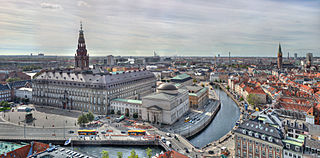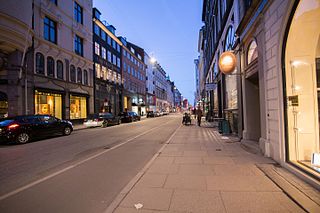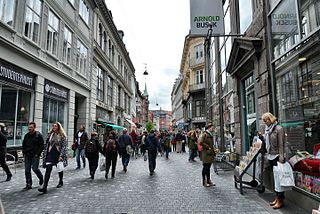
Copenhagen is the capital and most populous city of Denmark, with a population of around 660,000 in the municipality and 1.4 million in the urban area. The city is on the islands of Zealand and Amager, separated from Malmö, Sweden, by the Øresund strait. The Øresund Bridge connects the two cities by rail and road.

Strøget is a pedestrian, car-free shopping area in Copenhagen, Denmark. This popular tourist attraction in the centre of town is one of the longest pedestrian shopping streets in Europe at 1.1 km. Located at the centre of the old city of Copenhagen, it has long been one of the most high-profile streets in the city.

Jan Gehl Hon. FAIA is a Danish architect and urban design consultant based in Copenhagen whose career has focused on improving the quality of urban life by re-orienting city design towards the pedestrian and cyclist. He is a founding partner of Gehl Architects.

Cycling advocacy consists of activities that call for, promote or enable increased adoption and support for cycling and improved safety and convenience for cyclists, usually within urbanized areas or semi-urban regions. Issues of concern typically include policy, administrative and legal changes ; advocating and establishing better cycling infrastructure ; public education regarding the health, transportational and environmental benefits of cycling for both individuals and communities, cycling and motoring skills; and increasing public and political support for bicycling.

City Hall Square is a public square in the centre of Copenhagen, Denmark, located in front of the Copenhagen City Hall. Its large size, central location, and affiliation with the city hall makes it a popular venue for a variety of events, celebrations and demonstrations. It is often used as a central point for measuring distances from Copenhagen.

Kongens Nytorv is a public square in Copenhagen, Denmark, centrally located at the end of the pedestrian street Strøget. The largest square of the city, it was laid out by Christian V in 1670 in connection with a major extension of the fortified city, and has an equestrian statue of him at its centre. The initiative moved the centre of the city from the medieval area around Gammeltorv, at that time a muddy medieval marketplace, to a cobbled new square with a garden complex, inspired by the Royal city planning seen in Paris from the early 17th century.

Gammeltorv is the oldest square in Copenhagen, Denmark. With adjoining Nytorv it forms a common space along the Strøget pedestrian zone. While the square dates back to the foundation of the city in the 12th century, most of its buildings were constructed after the Great Fire of 1795 in Neoclassical style. Another dominating feature is the Caritas Well, a Renaissance fountain erected by King Christian IV in 1610.

Nytorv is a public square in the centre of Copenhagen, Denmark. Together with the adjoining Gammeltorv it forms a common space, today part of the Strøget pedestrian zone. The square is dominated by the imposing Neoclassical façade of the Copenhagen Court House, which from 1815-1905 also served as the City Hall.

Cobe is a Copenhagen-based architectural firm owned and managed by architect Dan Stubbergaard. As of 2020, the office has 150 employees and is involved in a large number of projects throughout Europe and North America within urban planning, architecture, landscape architecture and interior design.

The architecture of Denmark has its origins in the Viking Age, richly revealed by archaeological finds. It became firmly established in the Middle Ages when first Romanesque, then Gothic churches and cathedrals sprang up throughout the country. It was during this period that, in a country with little access to stone, brick became the construction material of choice, not just for churches but also for fortifications and castles.

Frederiksstaden is a district in Copenhagen, Denmark. Constructed during the reign of Frederick V in the second half of the 18th century, it is considered to be one of the most important rococo complexes in Europe and was included in the 2006 Danish Culture Canon.

The Royal Danish Playhouse is a theatre building for the Royal Danish Theatre, situated on the harbour front in the Frederiksstaden neighbourhood of central Copenhagen, Denmark. It was created as a purpose-built venue for dramatic theatre, supplementing the theatre's old venue from 1874 on Kongens Nytorv and the 2004 Copenhagen Opera House, which are used for ballet and opera.

Gråbrødretorv is a public square in the centre of Copenhagen, Denmark, just off the pedestrian street Strøget.

Amagertorv is a public square in the district of Indre By in central Copenhagen, Denmark. Today it forms part of the Strøget pedestrian zone, and is often described as the most central square in Copenhagen. Second only to Gammeltorv, it is also one of the oldest, taking its name from the Amager farmers who in the Middle Ages came into town to sell their produce at the site.

Fiolstræde is a pedestrianised shopping street in central Copenhagen, Denmark. It passes the square Frue Plads on its way from Nørreport station in the north to Skindergade in the south where Jorcks Passage connects it to the shopping street Strøget. Copenhagen Cathedral is located on the street which also passes the rear side of Copenhagen University Library.

Sankt Annæ Plads is a public square which marks the border between the Nyhavn area and Frederiksstaden neighborhoods of central Copenhagen, Denmark. It is a long narrow rectangle which extends inland from the waterfront, at a point just north of the Royal Danish Playhouse at the base of the Kvæsthus Pier, now known as Ofelia Plads, until it meets Bredgade. A major renovation of the square was completed in 2016.The Garrison Church is located on the south side of the square. Amaliegade, one of the two axes on which Frederiksstaden is centered, extends from the square.

Bredgade is one of the most prominent streets in Copenhagen, Denmark. Running in a straight line from Kongens Nytorv for just under one kilometre to the intersection of Esplanaden and Grønningen, it is one of the major streets in Frederiksstaden, a Rococo district laid out in the middle of the 18th century to commemorate the tercentenary of the House of Oldenburg's accession to the Danish throne. It is lined with a number of fine mansions as well as other historic buildings. Many law firms, trade unions, fashion stores and art galleries are based in the street. The street also runs parallel to the Royal residence Amalienborg and Frederik's Church

Gehl is an urban research and design consulting firm based in Copenhagen, Denmark. It was founded in 2000 by Professor Jan Gehl and urban designer Helle Søholt as a continuation of Gehl's research within the area over the past four decades. The firm specialises in improving the quality of urban life by re-orienting city design towards pedestrians and cyclists.

Købmagergade is a pedestrian shopping street in the Old Town of Copenhagen, Denmark. It connects Amagertorv on Strøget to Nørreport station, although the last section, north of Kultorvet, is part of Frederiksborggade, which continues on the other side of the railway station.

Kultorvet is a public square in the Old Town of Copenhagen, Denmark. Together with Købmagergade and the southern part of Frederiksborggade, it forms a pedestrian zone between Nørreport station and Amagertorv on Strøget. The square is lined with cafés and shops and is a popular venue for outdoor concerts in the summer time. Copenhagen Central Library was from the 1950s based on the square but has now relocated to a building in Krystalgade. Its old building has now been taken over by Niels Brock Copenhagen Business College.























